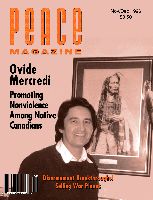
Peace Magazine Nov-Dec 1996, page 19. Some rights reserved.
Search for other articles by Ernie Regehr here
Edited by Jasjit Singh. British American Security Information Council and Indian Pugwash Society, 1995. 170 pp
The world at any one time hosts an average of three dozen wars. And in virtually all of these, the primary instruments of death are handguns, automatic rifles, landmines, grenades, and various other, largely low-tech, personal weapons known as "small arms and light weapons" (SALWs). Yet surprisingly little is known of the actual volume of such weapons in circulation and use, and the routes by which they reach the killing fields.
Activist groups and human rights organizations have been publicizing information on small arms in relation to particular conflicts, but only recently has the international research community turned its attention from the trade of major weapons to SALWs.
For the past two years the British American Security Information Council (BASIC) has been coordinating an international Light Weapons Project. This book is a product of that project, and is edited by a member of its advisory panel, Jasjit Singh, Director of the Institute for Defence Studies and Analyses in New Delhi.
Light Weapons and International Security is a collection of papers presented to an international workshop in New Delhi sponsored by BASIC and Pugwash. The volume is anchored by Klare's exploration of the relationship between the spread of light weapons and the incidence of post-Cold War violence. He explores the limits of applying to light weapons the term "proliferation" that helped our understanding of the arms trade as rooted in superpower rivalry, and instead suggests "diffusion" as a term to describe the spread of light weapons throughout all levels of society: "diffusion" suggests the dispersion of arms within societies, extending ... to private armies and militias, insurgent groups, criminal organizations, and other non-state actors.
Jasjit Singh expands on the theme of internal conflict and light weapons, linking the weaponization of societies to the long-term pursuit of low-intensity conflict. The collection includes a very useful analysis by the BASIC project co-ordinators, Susannah Dyer and Natalie Goldring, of the most prominent current proposals to limit and control light weapons and Singh's recommendation of policies and initiatives in support of controls. The close links between light weapons demand and current or imminent conflict lead them to situate control efforts squarely in the context of war prevention and war termination diplomacy. Inevitably, because small arms are linked to conflicts which are internal rather than international, their control is to a significant degree the issue of domestic gun control.
These context setting pieces are complemented by two regional studies - southern Asia, and South Africa - and a look at the connection between drug and gun trafficking in southern Asia. An exploration of the desirability and feasibility of establishing an international database on light weapons to gather the disparate bits of information yielded by local and regional studies, completes this fine collection.
In a world much more skilled in making war than peace, the most common means by which wars are ended seems to be exhaustion. Wars wind down when the will and the means to fight are finally dissipated. Tragically, what seems to bolster the will to fight is the availability of the means. In other words, the diffusion of small arms and light weapons frustrates the international community's efforts to prevent war - which qualifies these BASIC-sponsored studies and other research efforts to stem the flow of SALWs as primary peacebuilding initiatives.
Reviewed by Ernie Regehr, Policy and Public Affairs Director of Project Ploughshares.

Peace Magazine Nov-Dec 1996, page 19. Some rights reserved.
Search for other articles by Ernie Regehr here